Employee Management and Manufacturing Decision Analysis Report
VerifiedAdded on 2022/11/29
|18
|4831
|389
Report
AI Summary
This report examines the critical role of decision-making in employee management, particularly within a manufacturing context, using Samsung as a case study. It emphasizes the importance of decision analysis and the application of various decision-making tools for optimal outcomes. The report outlines a decision problem concerning mobile device selection for employees, considering multiple objectives like improving performance and minimizing operational defects. It then applies the Simple Multi-Attribute Rating Technique (SMART) to evaluate alternatives from different smartphone brands (Samsung, Apple, Huawei, LG, and Nokia). The analysis includes identifying decision-makers, alternatives, and relevant attributes, and then weighting and rating those attributes to arrive at a final decision. The report details the strengths and limitations of the SMART method, highlighting its ability to provide a structured framework for decision-making while acknowledging its inability to capture the full complexities of a decision problem. It underscores the need for a systematic, visual, and quantitative approach to address and evaluate important choices in business, emphasizing the importance of identifying alternatives and analyzing their consequences.
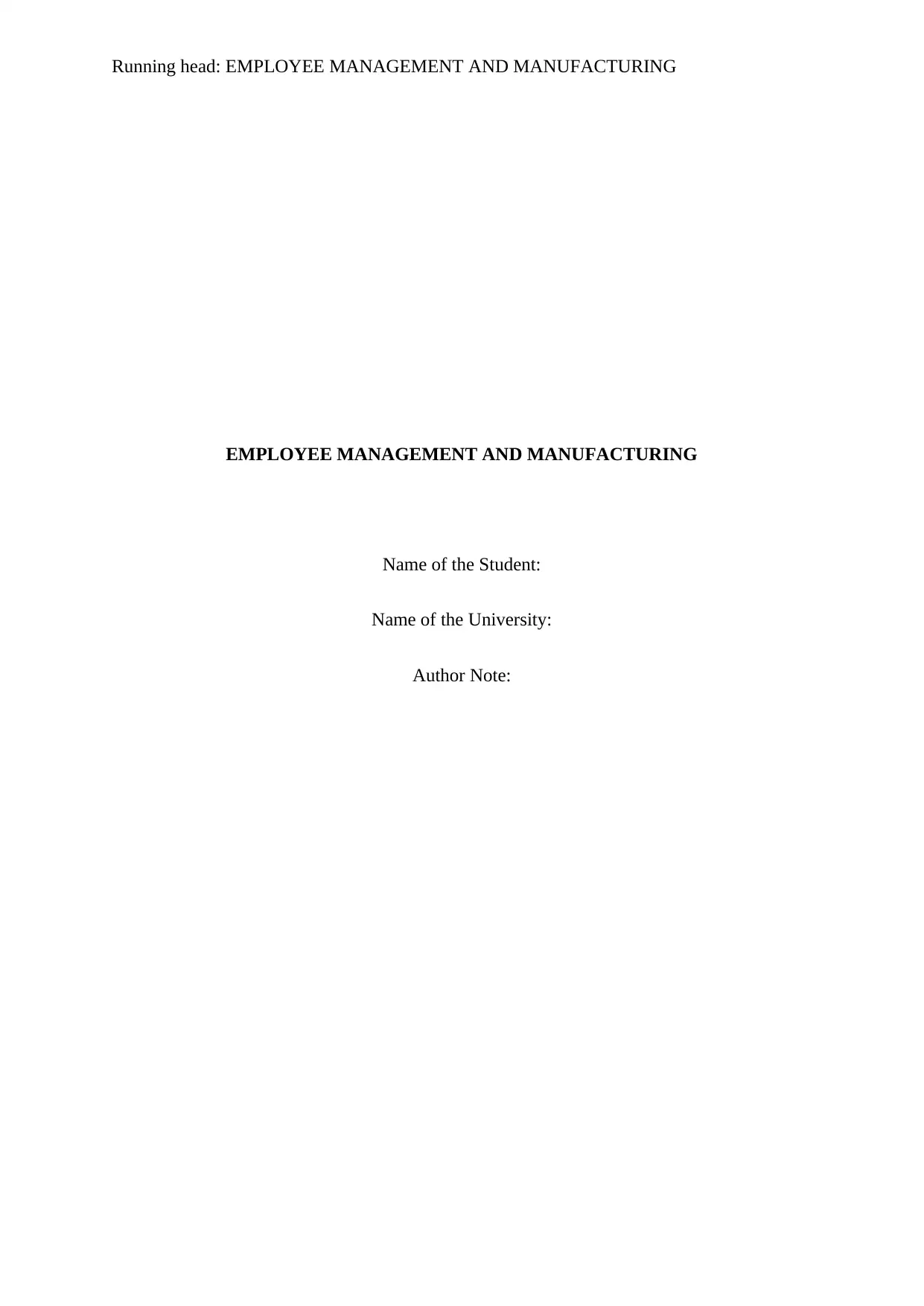
Running head: EMPLOYEE MANAGEMENT AND MANUFACTURING
EMPLOYEE MANAGEMENT AND MANUFACTURING
Name of the Student:
Name of the University:
Author Note:
EMPLOYEE MANAGEMENT AND MANUFACTURING
Name of the Student:
Name of the University:
Author Note:
Paraphrase This Document
Need a fresh take? Get an instant paraphrase of this document with our AI Paraphraser
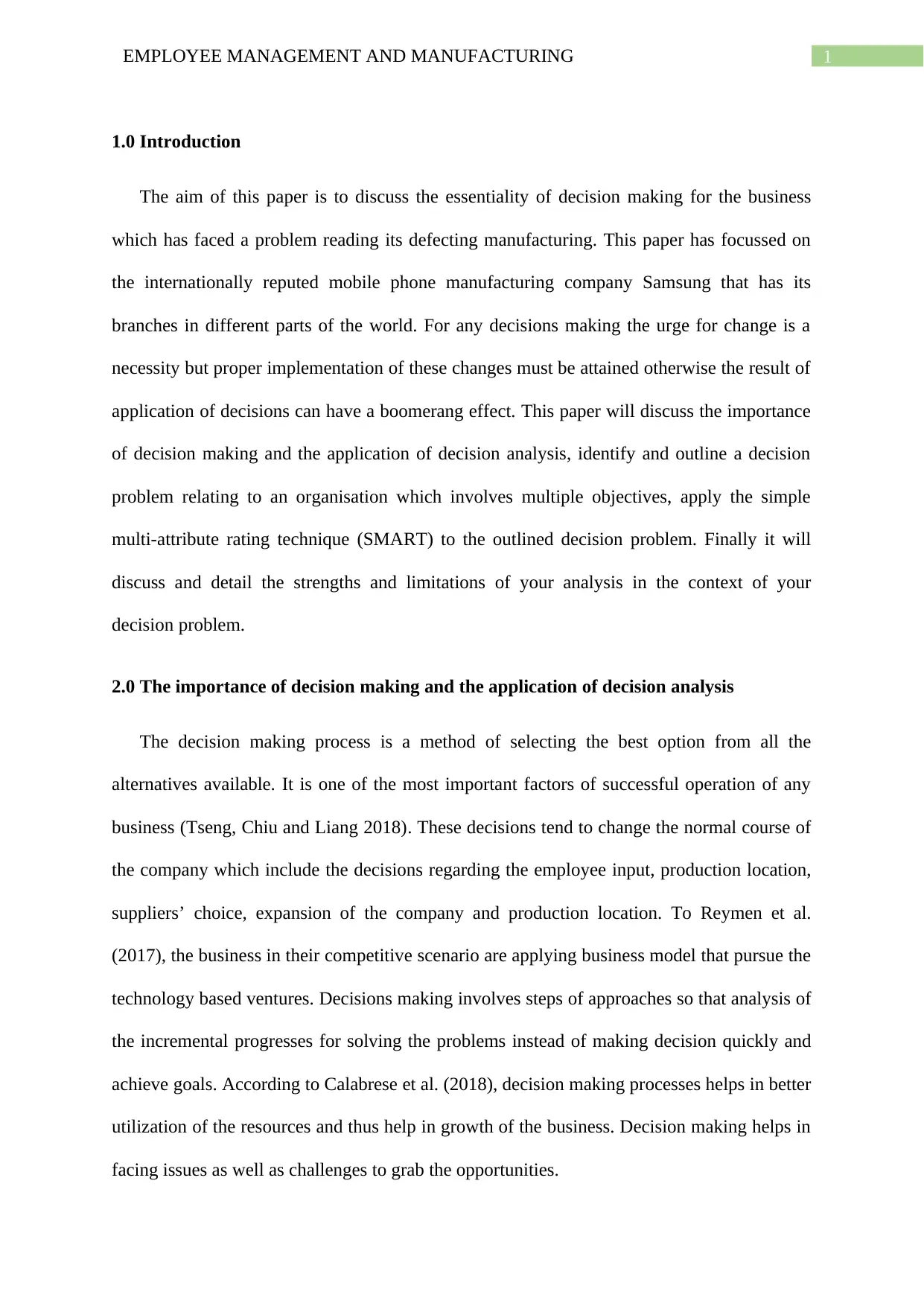
1EMPLOYEE MANAGEMENT AND MANUFACTURING
1.0 Introduction
The aim of this paper is to discuss the essentiality of decision making for the business
which has faced a problem reading its defecting manufacturing. This paper has focussed on
the internationally reputed mobile phone manufacturing company Samsung that has its
branches in different parts of the world. For any decisions making the urge for change is a
necessity but proper implementation of these changes must be attained otherwise the result of
application of decisions can have a boomerang effect. This paper will discuss the importance
of decision making and the application of decision analysis, identify and outline a decision
problem relating to an organisation which involves multiple objectives, apply the simple
multi-attribute rating technique (SMART) to the outlined decision problem. Finally it will
discuss and detail the strengths and limitations of your analysis in the context of your
decision problem.
2.0 The importance of decision making and the application of decision analysis
The decision making process is a method of selecting the best option from all the
alternatives available. It is one of the most important factors of successful operation of any
business (Tseng, Chiu and Liang 2018). These decisions tend to change the normal course of
the company which include the decisions regarding the employee input, production location,
suppliers’ choice, expansion of the company and production location. To Reymen et al.
(2017), the business in their competitive scenario are applying business model that pursue the
technology based ventures. Decisions making involves steps of approaches so that analysis of
the incremental progresses for solving the problems instead of making decision quickly and
achieve goals. According to Calabrese et al. (2018), decision making processes helps in better
utilization of the resources and thus help in growth of the business. Decision making helps in
facing issues as well as challenges to grab the opportunities.
1.0 Introduction
The aim of this paper is to discuss the essentiality of decision making for the business
which has faced a problem reading its defecting manufacturing. This paper has focussed on
the internationally reputed mobile phone manufacturing company Samsung that has its
branches in different parts of the world. For any decisions making the urge for change is a
necessity but proper implementation of these changes must be attained otherwise the result of
application of decisions can have a boomerang effect. This paper will discuss the importance
of decision making and the application of decision analysis, identify and outline a decision
problem relating to an organisation which involves multiple objectives, apply the simple
multi-attribute rating technique (SMART) to the outlined decision problem. Finally it will
discuss and detail the strengths and limitations of your analysis in the context of your
decision problem.
2.0 The importance of decision making and the application of decision analysis
The decision making process is a method of selecting the best option from all the
alternatives available. It is one of the most important factors of successful operation of any
business (Tseng, Chiu and Liang 2018). These decisions tend to change the normal course of
the company which include the decisions regarding the employee input, production location,
suppliers’ choice, expansion of the company and production location. To Reymen et al.
(2017), the business in their competitive scenario are applying business model that pursue the
technology based ventures. Decisions making involves steps of approaches so that analysis of
the incremental progresses for solving the problems instead of making decision quickly and
achieve goals. According to Calabrese et al. (2018), decision making processes helps in better
utilization of the resources and thus help in growth of the business. Decision making helps in
facing issues as well as challenges to grab the opportunities.
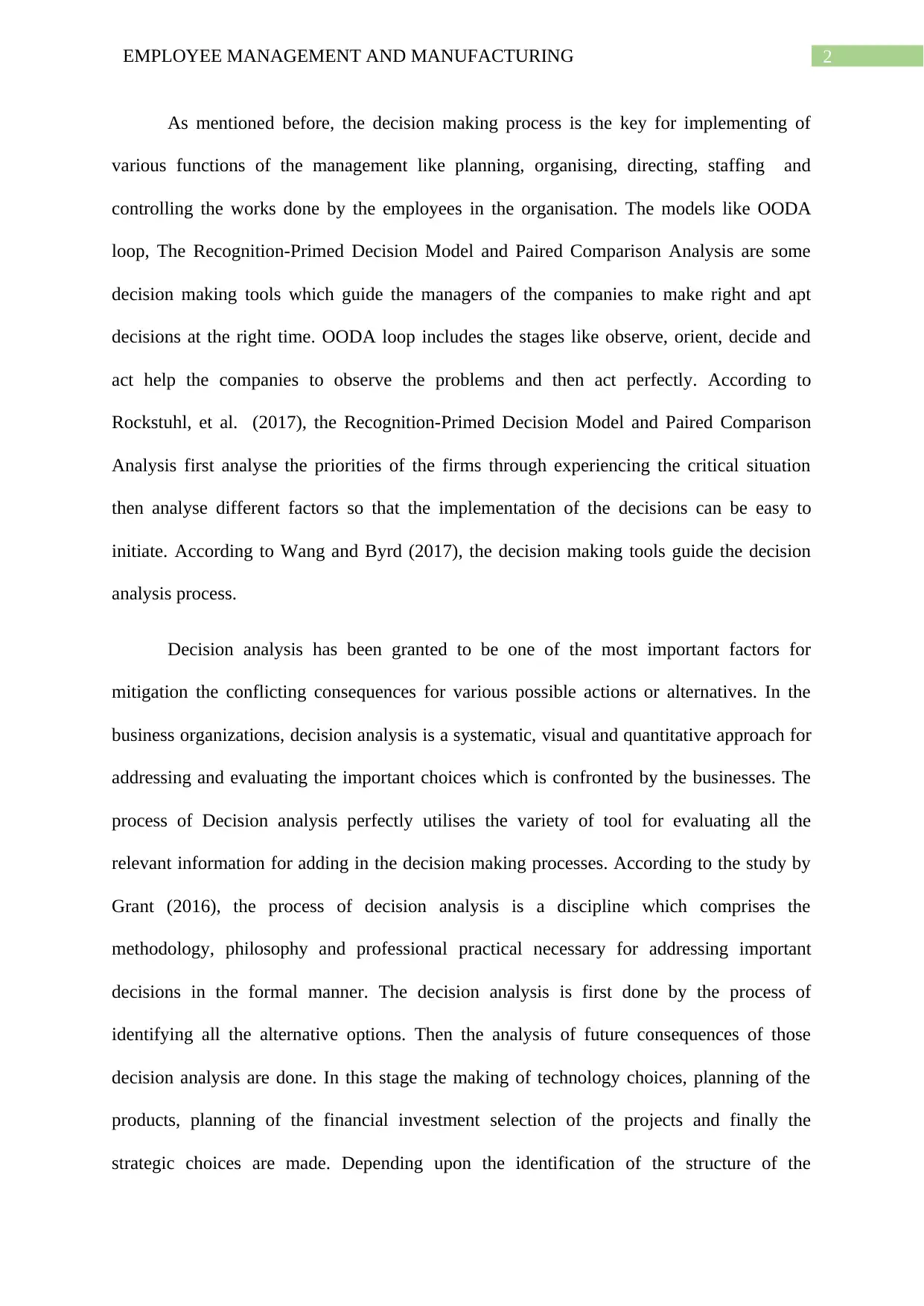
2EMPLOYEE MANAGEMENT AND MANUFACTURING
As mentioned before, the decision making process is the key for implementing of
various functions of the management like planning, organising, directing, staffing and
controlling the works done by the employees in the organisation. The models like OODA
loop, The Recognition-Primed Decision Model and Paired Comparison Analysis are some
decision making tools which guide the managers of the companies to make right and apt
decisions at the right time. OODA loop includes the stages like observe, orient, decide and
act help the companies to observe the problems and then act perfectly. According to
Rockstuhl, et al. (2017), the Recognition-Primed Decision Model and Paired Comparison
Analysis first analyse the priorities of the firms through experiencing the critical situation
then analyse different factors so that the implementation of the decisions can be easy to
initiate. According to Wang and Byrd (2017), the decision making tools guide the decision
analysis process.
Decision analysis has been granted to be one of the most important factors for
mitigation the conflicting consequences for various possible actions or alternatives. In the
business organizations, decision analysis is a systematic, visual and quantitative approach for
addressing and evaluating the important choices which is confronted by the businesses. The
process of Decision analysis perfectly utilises the variety of tool for evaluating all the
relevant information for adding in the decision making processes. According to the study by
Grant (2016), the process of decision analysis is a discipline which comprises the
methodology, philosophy and professional practical necessary for addressing important
decisions in the formal manner. The decision analysis is first done by the process of
identifying all the alternative options. Then the analysis of future consequences of those
decision analysis are done. In this stage the making of technology choices, planning of the
products, planning of the financial investment selection of the projects and finally the
strategic choices are made. Depending upon the identification of the structure of the
As mentioned before, the decision making process is the key for implementing of
various functions of the management like planning, organising, directing, staffing and
controlling the works done by the employees in the organisation. The models like OODA
loop, The Recognition-Primed Decision Model and Paired Comparison Analysis are some
decision making tools which guide the managers of the companies to make right and apt
decisions at the right time. OODA loop includes the stages like observe, orient, decide and
act help the companies to observe the problems and then act perfectly. According to
Rockstuhl, et al. (2017), the Recognition-Primed Decision Model and Paired Comparison
Analysis first analyse the priorities of the firms through experiencing the critical situation
then analyse different factors so that the implementation of the decisions can be easy to
initiate. According to Wang and Byrd (2017), the decision making tools guide the decision
analysis process.
Decision analysis has been granted to be one of the most important factors for
mitigation the conflicting consequences for various possible actions or alternatives. In the
business organizations, decision analysis is a systematic, visual and quantitative approach for
addressing and evaluating the important choices which is confronted by the businesses. The
process of Decision analysis perfectly utilises the variety of tool for evaluating all the
relevant information for adding in the decision making processes. According to the study by
Grant (2016), the process of decision analysis is a discipline which comprises the
methodology, philosophy and professional practical necessary for addressing important
decisions in the formal manner. The decision analysis is first done by the process of
identifying all the alternative options. Then the analysis of future consequences of those
decision analysis are done. In this stage the making of technology choices, planning of the
products, planning of the financial investment selection of the projects and finally the
strategic choices are made. Depending upon the identification of the structure of the
⊘ This is a preview!⊘
Do you want full access?
Subscribe today to unlock all pages.

Trusted by 1+ million students worldwide
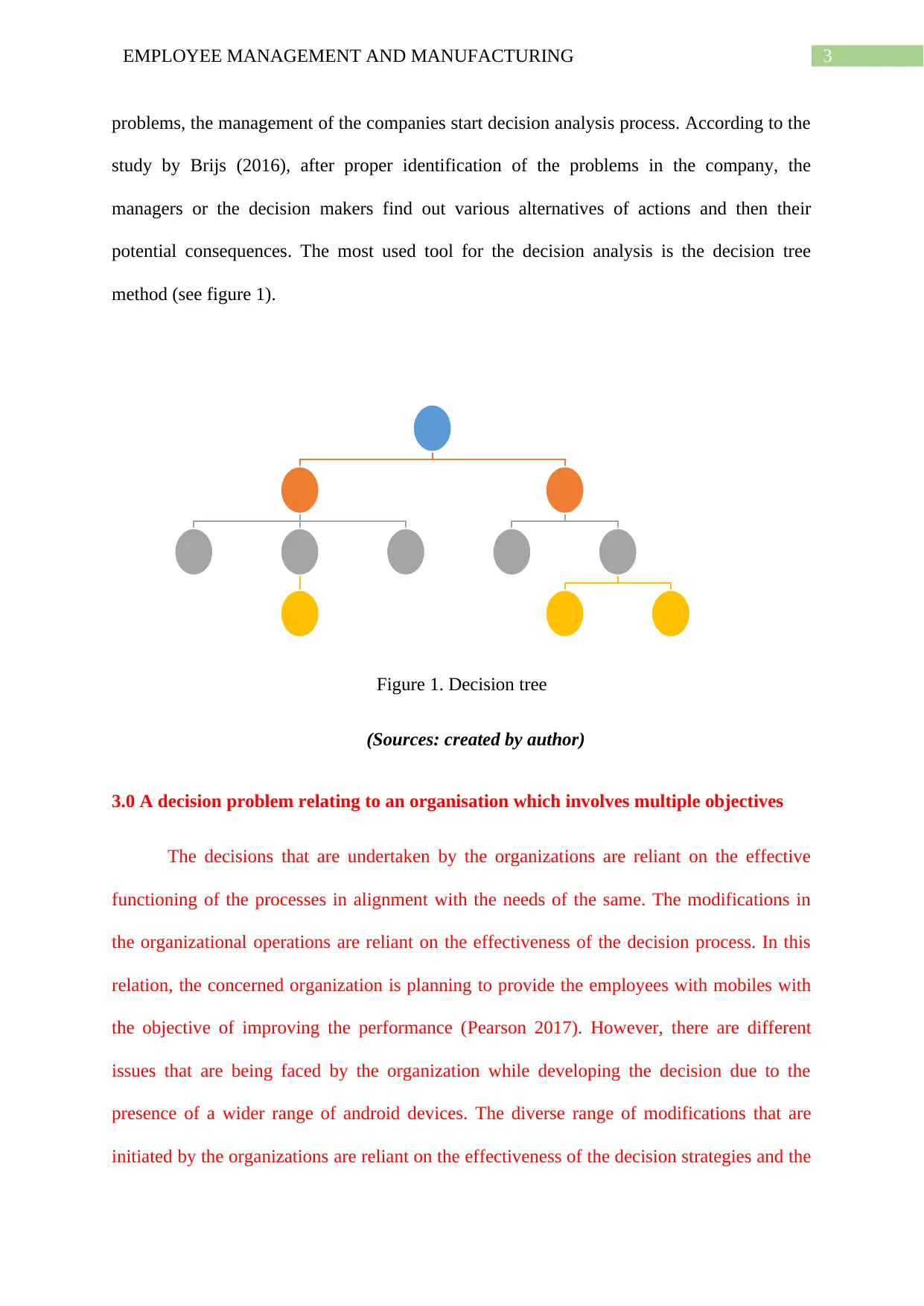
3EMPLOYEE MANAGEMENT AND MANUFACTURING
problems, the management of the companies start decision analysis process. According to the
study by Brijs (2016), after proper identification of the problems in the company, the
managers or the decision makers find out various alternatives of actions and then their
potential consequences. The most used tool for the decision analysis is the decision tree
method (see figure 1).
Figure 1. Decision tree
(Sources: created by author)
3.0 A decision problem relating to an organisation which involves multiple objectives
The decisions that are undertaken by the organizations are reliant on the effective
functioning of the processes in alignment with the needs of the same. The modifications in
the organizational operations are reliant on the effectiveness of the decision process. In this
relation, the concerned organization is planning to provide the employees with mobiles with
the objective of improving the performance (Pearson 2017). However, there are different
issues that are being faced by the organization while developing the decision due to the
presence of a wider range of android devices. The diverse range of modifications that are
initiated by the organizations are reliant on the effectiveness of the decision strategies and the
problems, the management of the companies start decision analysis process. According to the
study by Brijs (2016), after proper identification of the problems in the company, the
managers or the decision makers find out various alternatives of actions and then their
potential consequences. The most used tool for the decision analysis is the decision tree
method (see figure 1).
Figure 1. Decision tree
(Sources: created by author)
3.0 A decision problem relating to an organisation which involves multiple objectives
The decisions that are undertaken by the organizations are reliant on the effective
functioning of the processes in alignment with the needs of the same. The modifications in
the organizational operations are reliant on the effectiveness of the decision process. In this
relation, the concerned organization is planning to provide the employees with mobiles with
the objective of improving the performance (Pearson 2017). However, there are different
issues that are being faced by the organization while developing the decision due to the
presence of a wider range of android devices. The diverse range of modifications that are
initiated by the organizations are reliant on the effectiveness of the decision strategies and the
Paraphrase This Document
Need a fresh take? Get an instant paraphrase of this document with our AI Paraphraser
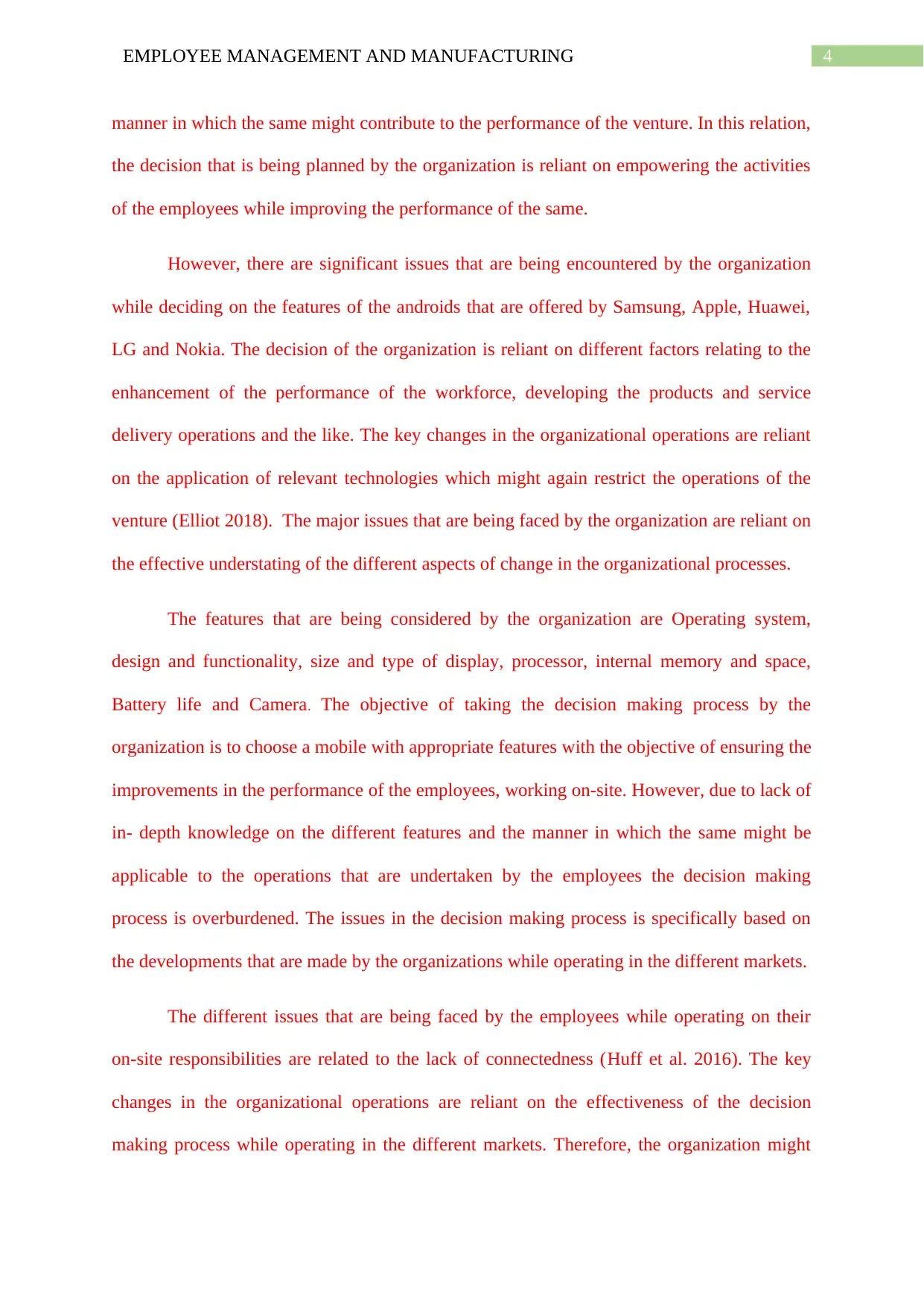
4EMPLOYEE MANAGEMENT AND MANUFACTURING
manner in which the same might contribute to the performance of the venture. In this relation,
the decision that is being planned by the organization is reliant on empowering the activities
of the employees while improving the performance of the same.
However, there are significant issues that are being encountered by the organization
while deciding on the features of the androids that are offered by Samsung, Apple, Huawei,
LG and Nokia. The decision of the organization is reliant on different factors relating to the
enhancement of the performance of the workforce, developing the products and service
delivery operations and the like. The key changes in the organizational operations are reliant
on the application of relevant technologies which might again restrict the operations of the
venture (Elliot 2018). The major issues that are being faced by the organization are reliant on
the effective understating of the different aspects of change in the organizational processes.
The features that are being considered by the organization are Operating system,
design and functionality, size and type of display, processor, internal memory and space,
Battery life and Camera. The objective of taking the decision making process by the
organization is to choose a mobile with appropriate features with the objective of ensuring the
improvements in the performance of the employees, working on-site. However, due to lack of
in- depth knowledge on the different features and the manner in which the same might be
applicable to the operations that are undertaken by the employees the decision making
process is overburdened. The issues in the decision making process is specifically based on
the developments that are made by the organizations while operating in the different markets.
The different issues that are being faced by the employees while operating on their
on-site responsibilities are related to the lack of connectedness (Huff et al. 2016). The key
changes in the organizational operations are reliant on the effectiveness of the decision
making process while operating in the different markets. Therefore, the organization might
manner in which the same might contribute to the performance of the venture. In this relation,
the decision that is being planned by the organization is reliant on empowering the activities
of the employees while improving the performance of the same.
However, there are significant issues that are being encountered by the organization
while deciding on the features of the androids that are offered by Samsung, Apple, Huawei,
LG and Nokia. The decision of the organization is reliant on different factors relating to the
enhancement of the performance of the workforce, developing the products and service
delivery operations and the like. The key changes in the organizational operations are reliant
on the application of relevant technologies which might again restrict the operations of the
venture (Elliot 2018). The major issues that are being faced by the organization are reliant on
the effective understating of the different aspects of change in the organizational processes.
The features that are being considered by the organization are Operating system,
design and functionality, size and type of display, processor, internal memory and space,
Battery life and Camera. The objective of taking the decision making process by the
organization is to choose a mobile with appropriate features with the objective of ensuring the
improvements in the performance of the employees, working on-site. However, due to lack of
in- depth knowledge on the different features and the manner in which the same might be
applicable to the operations that are undertaken by the employees the decision making
process is overburdened. The issues in the decision making process is specifically based on
the developments that are made by the organizations while operating in the different markets.
The different issues that are being faced by the employees while operating on their
on-site responsibilities are related to the lack of connectedness (Huff et al. 2016). The key
changes in the organizational operations are reliant on the effectiveness of the decision
making process while operating in the different markets. Therefore, the organization might
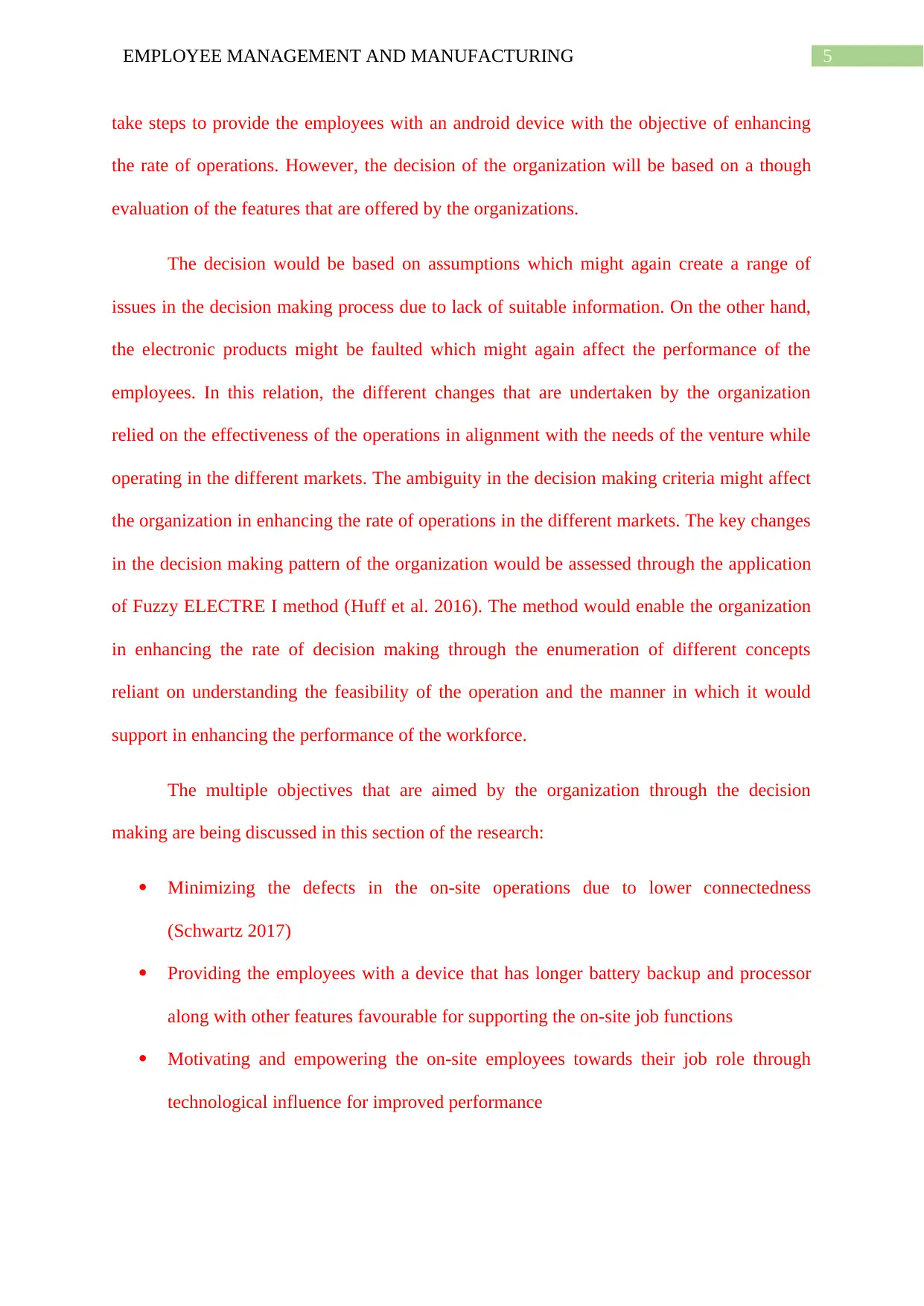
5EMPLOYEE MANAGEMENT AND MANUFACTURING
take steps to provide the employees with an android device with the objective of enhancing
the rate of operations. However, the decision of the organization will be based on a though
evaluation of the features that are offered by the organizations.
The decision would be based on assumptions which might again create a range of
issues in the decision making process due to lack of suitable information. On the other hand,
the electronic products might be faulted which might again affect the performance of the
employees. In this relation, the different changes that are undertaken by the organization
relied on the effectiveness of the operations in alignment with the needs of the venture while
operating in the different markets. The ambiguity in the decision making criteria might affect
the organization in enhancing the rate of operations in the different markets. The key changes
in the decision making pattern of the organization would be assessed through the application
of Fuzzy ELECTRE I method (Huff et al. 2016). The method would enable the organization
in enhancing the rate of decision making through the enumeration of different concepts
reliant on understanding the feasibility of the operation and the manner in which it would
support in enhancing the performance of the workforce.
The multiple objectives that are aimed by the organization through the decision
making are being discussed in this section of the research:
Minimizing the defects in the on-site operations due to lower connectedness
(Schwartz 2017)
Providing the employees with a device that has longer battery backup and processor
along with other features favourable for supporting the on-site job functions
Motivating and empowering the on-site employees towards their job role through
technological influence for improved performance
take steps to provide the employees with an android device with the objective of enhancing
the rate of operations. However, the decision of the organization will be based on a though
evaluation of the features that are offered by the organizations.
The decision would be based on assumptions which might again create a range of
issues in the decision making process due to lack of suitable information. On the other hand,
the electronic products might be faulted which might again affect the performance of the
employees. In this relation, the different changes that are undertaken by the organization
relied on the effectiveness of the operations in alignment with the needs of the venture while
operating in the different markets. The ambiguity in the decision making criteria might affect
the organization in enhancing the rate of operations in the different markets. The key changes
in the decision making pattern of the organization would be assessed through the application
of Fuzzy ELECTRE I method (Huff et al. 2016). The method would enable the organization
in enhancing the rate of decision making through the enumeration of different concepts
reliant on understanding the feasibility of the operation and the manner in which it would
support in enhancing the performance of the workforce.
The multiple objectives that are aimed by the organization through the decision
making are being discussed in this section of the research:
Minimizing the defects in the on-site operations due to lower connectedness
(Schwartz 2017)
Providing the employees with a device that has longer battery backup and processor
along with other features favourable for supporting the on-site job functions
Motivating and empowering the on-site employees towards their job role through
technological influence for improved performance
⊘ This is a preview!⊘
Do you want full access?
Subscribe today to unlock all pages.

Trusted by 1+ million students worldwide
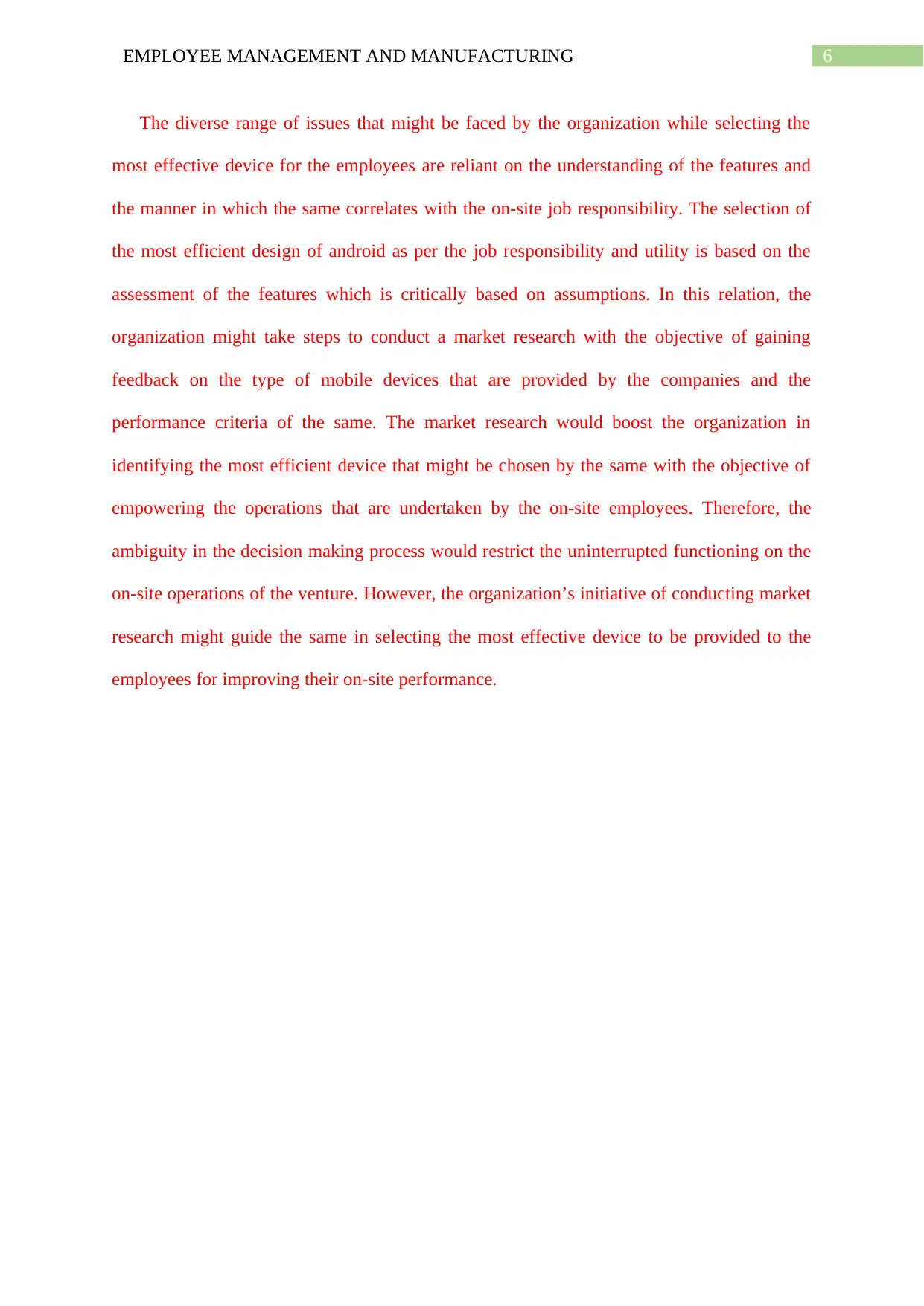
6EMPLOYEE MANAGEMENT AND MANUFACTURING
The diverse range of issues that might be faced by the organization while selecting the
most effective device for the employees are reliant on the understanding of the features and
the manner in which the same correlates with the on-site job responsibility. The selection of
the most efficient design of android as per the job responsibility and utility is based on the
assessment of the features which is critically based on assumptions. In this relation, the
organization might take steps to conduct a market research with the objective of gaining
feedback on the type of mobile devices that are provided by the companies and the
performance criteria of the same. The market research would boost the organization in
identifying the most efficient device that might be chosen by the same with the objective of
empowering the operations that are undertaken by the on-site employees. Therefore, the
ambiguity in the decision making process would restrict the uninterrupted functioning on the
on-site operations of the venture. However, the organization’s initiative of conducting market
research might guide the same in selecting the most effective device to be provided to the
employees for improving their on-site performance.
The diverse range of issues that might be faced by the organization while selecting the
most effective device for the employees are reliant on the understanding of the features and
the manner in which the same correlates with the on-site job responsibility. The selection of
the most efficient design of android as per the job responsibility and utility is based on the
assessment of the features which is critically based on assumptions. In this relation, the
organization might take steps to conduct a market research with the objective of gaining
feedback on the type of mobile devices that are provided by the companies and the
performance criteria of the same. The market research would boost the organization in
identifying the most efficient device that might be chosen by the same with the objective of
empowering the operations that are undertaken by the on-site employees. Therefore, the
ambiguity in the decision making process would restrict the uninterrupted functioning on the
on-site operations of the venture. However, the organization’s initiative of conducting market
research might guide the same in selecting the most effective device to be provided to the
employees for improving their on-site performance.
Paraphrase This Document
Need a fresh take? Get an instant paraphrase of this document with our AI Paraphraser
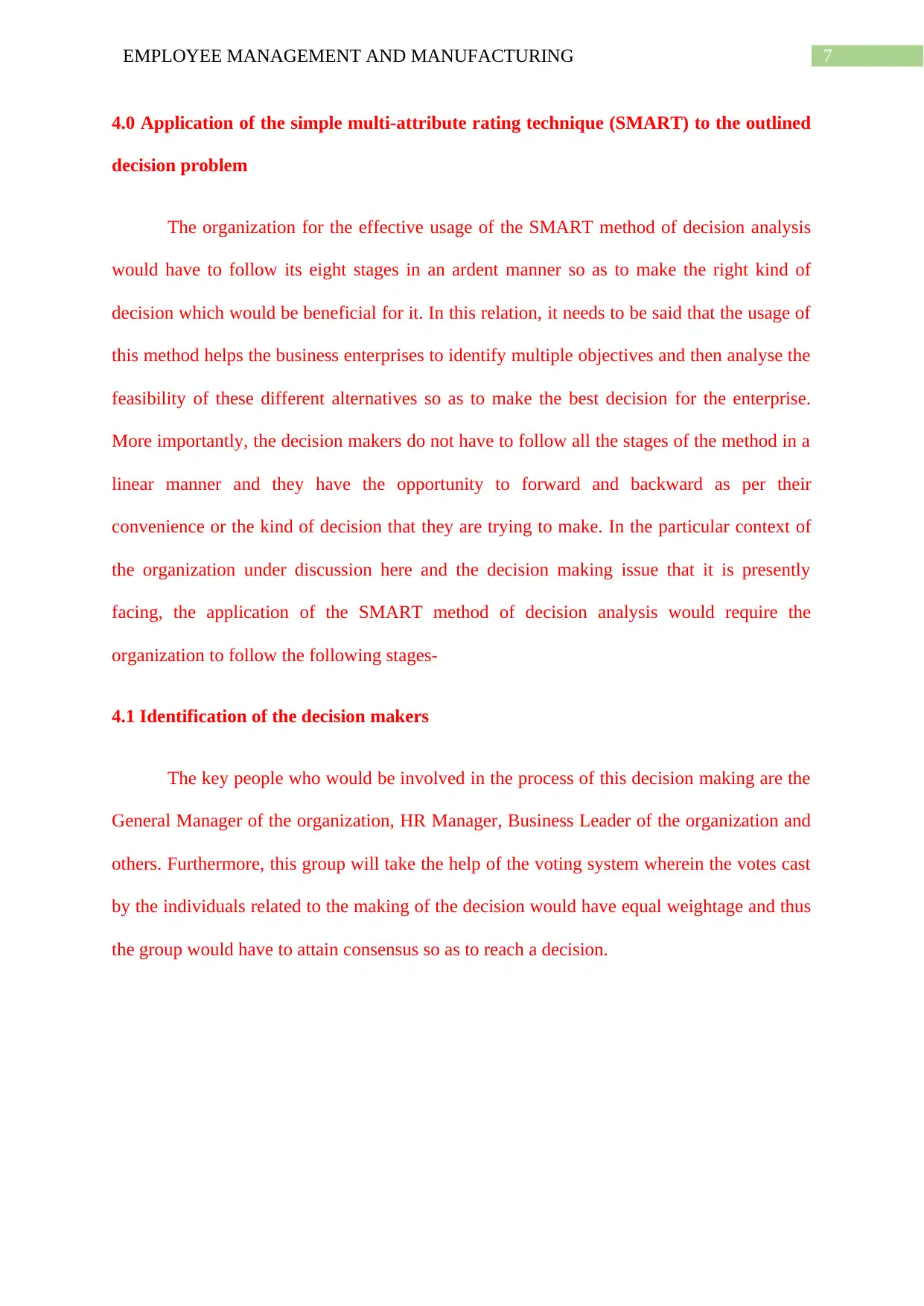
7EMPLOYEE MANAGEMENT AND MANUFACTURING
4.0 Application of the simple multi-attribute rating technique (SMART) to the outlined
decision problem
The organization for the effective usage of the SMART method of decision analysis
would have to follow its eight stages in an ardent manner so as to make the right kind of
decision which would be beneficial for it. In this relation, it needs to be said that the usage of
this method helps the business enterprises to identify multiple objectives and then analyse the
feasibility of these different alternatives so as to make the best decision for the enterprise.
More importantly, the decision makers do not have to follow all the stages of the method in a
linear manner and they have the opportunity to forward and backward as per their
convenience or the kind of decision that they are trying to make. In the particular context of
the organization under discussion here and the decision making issue that it is presently
facing, the application of the SMART method of decision analysis would require the
organization to follow the following stages-
4.1 Identification of the decision makers
The key people who would be involved in the process of this decision making are the
General Manager of the organization, HR Manager, Business Leader of the organization and
others. Furthermore, this group will take the help of the voting system wherein the votes cast
by the individuals related to the making of the decision would have equal weightage and thus
the group would have to attain consensus so as to reach a decision.
4.0 Application of the simple multi-attribute rating technique (SMART) to the outlined
decision problem
The organization for the effective usage of the SMART method of decision analysis
would have to follow its eight stages in an ardent manner so as to make the right kind of
decision which would be beneficial for it. In this relation, it needs to be said that the usage of
this method helps the business enterprises to identify multiple objectives and then analyse the
feasibility of these different alternatives so as to make the best decision for the enterprise.
More importantly, the decision makers do not have to follow all the stages of the method in a
linear manner and they have the opportunity to forward and backward as per their
convenience or the kind of decision that they are trying to make. In the particular context of
the organization under discussion here and the decision making issue that it is presently
facing, the application of the SMART method of decision analysis would require the
organization to follow the following stages-
4.1 Identification of the decision makers
The key people who would be involved in the process of this decision making are the
General Manager of the organization, HR Manager, Business Leader of the organization and
others. Furthermore, this group will take the help of the voting system wherein the votes cast
by the individuals related to the making of the decision would have equal weightage and thus
the group would have to attain consensus so as to reach a decision.
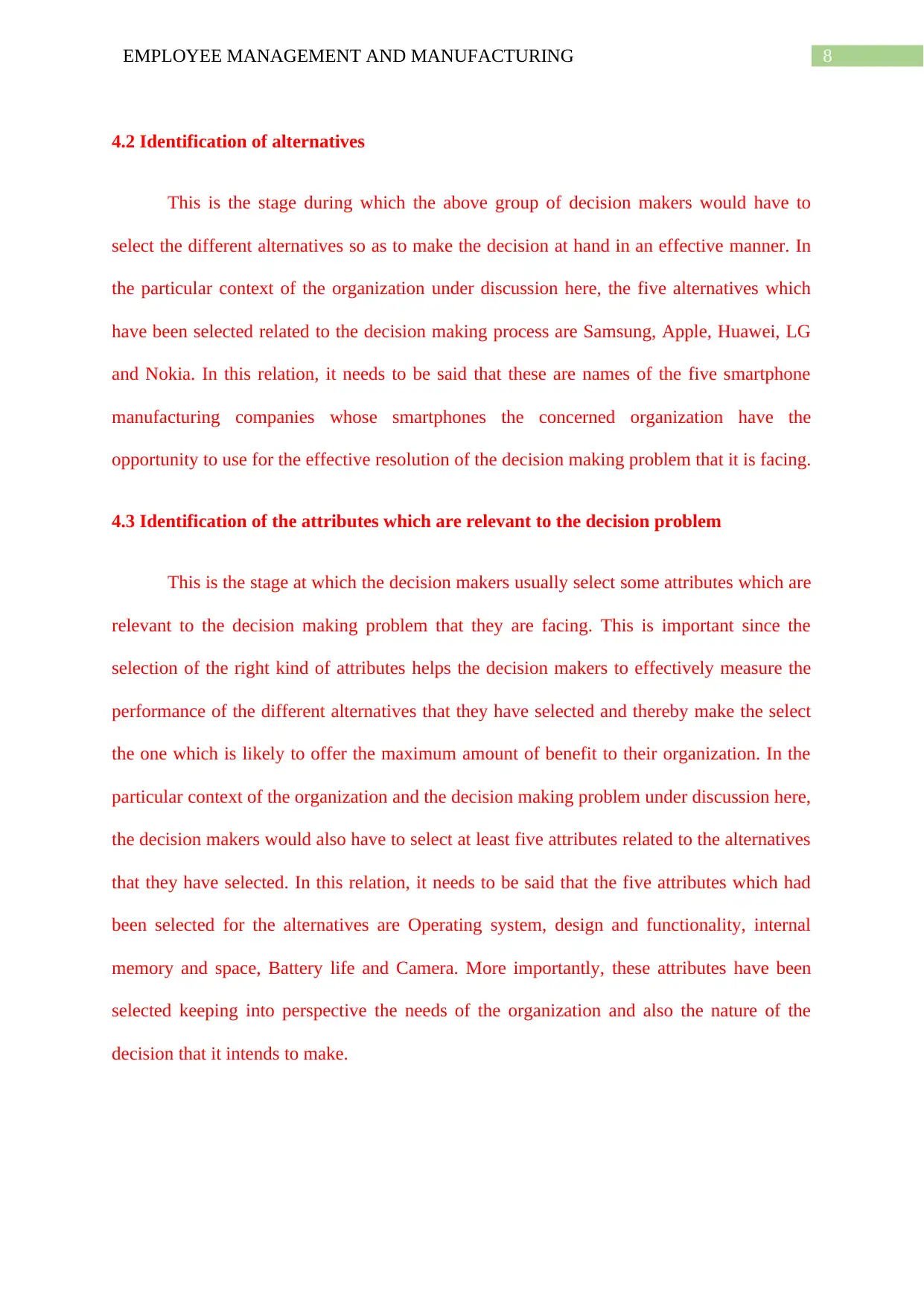
8EMPLOYEE MANAGEMENT AND MANUFACTURING
4.2 Identification of alternatives
This is the stage during which the above group of decision makers would have to
select the different alternatives so as to make the decision at hand in an effective manner. In
the particular context of the organization under discussion here, the five alternatives which
have been selected related to the decision making process are Samsung, Apple, Huawei, LG
and Nokia. In this relation, it needs to be said that these are names of the five smartphone
manufacturing companies whose smartphones the concerned organization have the
opportunity to use for the effective resolution of the decision making problem that it is facing.
4.3 Identification of the attributes which are relevant to the decision problem
This is the stage at which the decision makers usually select some attributes which are
relevant to the decision making problem that they are facing. This is important since the
selection of the right kind of attributes helps the decision makers to effectively measure the
performance of the different alternatives that they have selected and thereby make the select
the one which is likely to offer the maximum amount of benefit to their organization. In the
particular context of the organization and the decision making problem under discussion here,
the decision makers would also have to select at least five attributes related to the alternatives
that they have selected. In this relation, it needs to be said that the five attributes which had
been selected for the alternatives are Operating system, design and functionality, internal
memory and space, Battery life and Camera. More importantly, these attributes have been
selected keeping into perspective the needs of the organization and also the nature of the
decision that it intends to make.
4.2 Identification of alternatives
This is the stage during which the above group of decision makers would have to
select the different alternatives so as to make the decision at hand in an effective manner. In
the particular context of the organization under discussion here, the five alternatives which
have been selected related to the decision making process are Samsung, Apple, Huawei, LG
and Nokia. In this relation, it needs to be said that these are names of the five smartphone
manufacturing companies whose smartphones the concerned organization have the
opportunity to use for the effective resolution of the decision making problem that it is facing.
4.3 Identification of the attributes which are relevant to the decision problem
This is the stage at which the decision makers usually select some attributes which are
relevant to the decision making problem that they are facing. This is important since the
selection of the right kind of attributes helps the decision makers to effectively measure the
performance of the different alternatives that they have selected and thereby make the select
the one which is likely to offer the maximum amount of benefit to their organization. In the
particular context of the organization and the decision making problem under discussion here,
the decision makers would also have to select at least five attributes related to the alternatives
that they have selected. In this relation, it needs to be said that the five attributes which had
been selected for the alternatives are Operating system, design and functionality, internal
memory and space, Battery life and Camera. More importantly, these attributes have been
selected keeping into perspective the needs of the organization and also the nature of the
decision that it intends to make.
⊘ This is a preview!⊘
Do you want full access?
Subscribe today to unlock all pages.

Trusted by 1+ million students worldwide
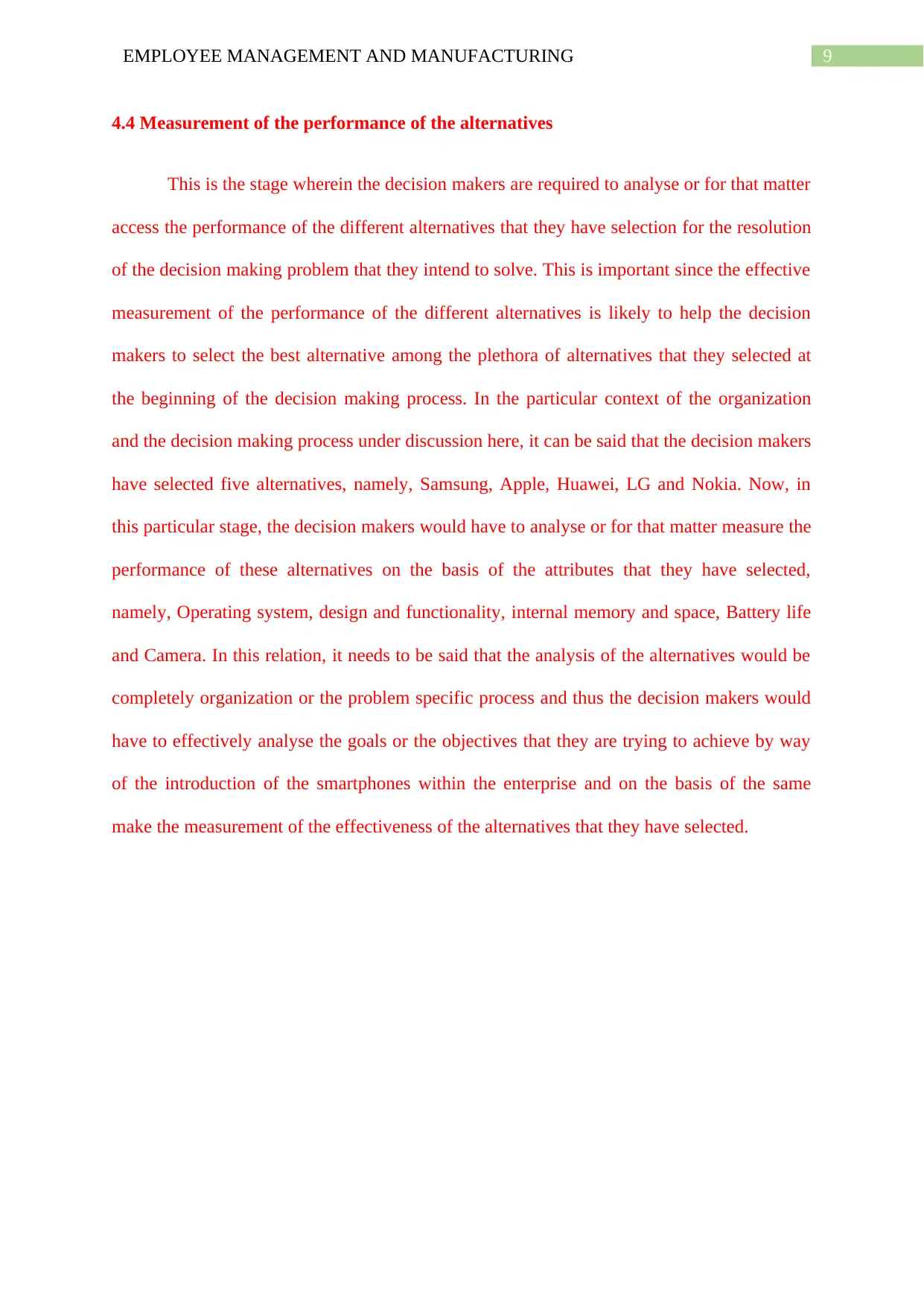
9EMPLOYEE MANAGEMENT AND MANUFACTURING
4.4 Measurement of the performance of the alternatives
This is the stage wherein the decision makers are required to analyse or for that matter
access the performance of the different alternatives that they have selection for the resolution
of the decision making problem that they intend to solve. This is important since the effective
measurement of the performance of the different alternatives is likely to help the decision
makers to select the best alternative among the plethora of alternatives that they selected at
the beginning of the decision making process. In the particular context of the organization
and the decision making process under discussion here, it can be said that the decision makers
have selected five alternatives, namely, Samsung, Apple, Huawei, LG and Nokia. Now, in
this particular stage, the decision makers would have to analyse or for that matter measure the
performance of these alternatives on the basis of the attributes that they have selected,
namely, Operating system, design and functionality, internal memory and space, Battery life
and Camera. In this relation, it needs to be said that the analysis of the alternatives would be
completely organization or the problem specific process and thus the decision makers would
have to effectively analyse the goals or the objectives that they are trying to achieve by way
of the introduction of the smartphones within the enterprise and on the basis of the same
make the measurement of the effectiveness of the alternatives that they have selected.
4.4 Measurement of the performance of the alternatives
This is the stage wherein the decision makers are required to analyse or for that matter
access the performance of the different alternatives that they have selection for the resolution
of the decision making problem that they intend to solve. This is important since the effective
measurement of the performance of the different alternatives is likely to help the decision
makers to select the best alternative among the plethora of alternatives that they selected at
the beginning of the decision making process. In the particular context of the organization
and the decision making process under discussion here, it can be said that the decision makers
have selected five alternatives, namely, Samsung, Apple, Huawei, LG and Nokia. Now, in
this particular stage, the decision makers would have to analyse or for that matter measure the
performance of these alternatives on the basis of the attributes that they have selected,
namely, Operating system, design and functionality, internal memory and space, Battery life
and Camera. In this relation, it needs to be said that the analysis of the alternatives would be
completely organization or the problem specific process and thus the decision makers would
have to effectively analyse the goals or the objectives that they are trying to achieve by way
of the introduction of the smartphones within the enterprise and on the basis of the same
make the measurement of the effectiveness of the alternatives that they have selected.
Paraphrase This Document
Need a fresh take? Get an instant paraphrase of this document with our AI Paraphraser
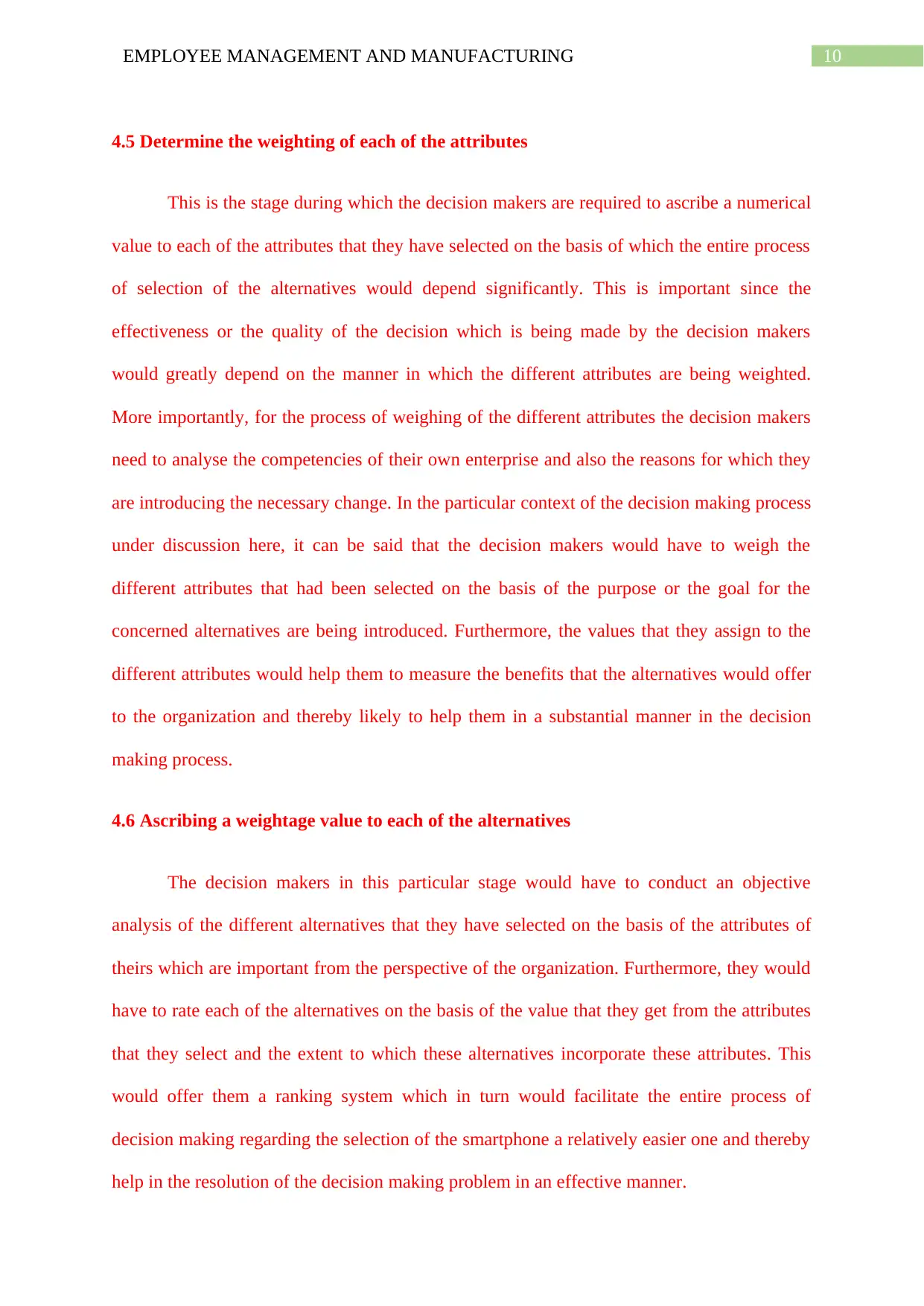
10EMPLOYEE MANAGEMENT AND MANUFACTURING
4.5 Determine the weighting of each of the attributes
This is the stage during which the decision makers are required to ascribe a numerical
value to each of the attributes that they have selected on the basis of which the entire process
of selection of the alternatives would depend significantly. This is important since the
effectiveness or the quality of the decision which is being made by the decision makers
would greatly depend on the manner in which the different attributes are being weighted.
More importantly, for the process of weighing of the different attributes the decision makers
need to analyse the competencies of their own enterprise and also the reasons for which they
are introducing the necessary change. In the particular context of the decision making process
under discussion here, it can be said that the decision makers would have to weigh the
different attributes that had been selected on the basis of the purpose or the goal for the
concerned alternatives are being introduced. Furthermore, the values that they assign to the
different attributes would help them to measure the benefits that the alternatives would offer
to the organization and thereby likely to help them in a substantial manner in the decision
making process.
4.6 Ascribing a weightage value to each of the alternatives
The decision makers in this particular stage would have to conduct an objective
analysis of the different alternatives that they have selected on the basis of the attributes of
theirs which are important from the perspective of the organization. Furthermore, they would
have to rate each of the alternatives on the basis of the value that they get from the attributes
that they select and the extent to which these alternatives incorporate these attributes. This
would offer them a ranking system which in turn would facilitate the entire process of
decision making regarding the selection of the smartphone a relatively easier one and thereby
help in the resolution of the decision making problem in an effective manner.
4.5 Determine the weighting of each of the attributes
This is the stage during which the decision makers are required to ascribe a numerical
value to each of the attributes that they have selected on the basis of which the entire process
of selection of the alternatives would depend significantly. This is important since the
effectiveness or the quality of the decision which is being made by the decision makers
would greatly depend on the manner in which the different attributes are being weighted.
More importantly, for the process of weighing of the different attributes the decision makers
need to analyse the competencies of their own enterprise and also the reasons for which they
are introducing the necessary change. In the particular context of the decision making process
under discussion here, it can be said that the decision makers would have to weigh the
different attributes that had been selected on the basis of the purpose or the goal for the
concerned alternatives are being introduced. Furthermore, the values that they assign to the
different attributes would help them to measure the benefits that the alternatives would offer
to the organization and thereby likely to help them in a substantial manner in the decision
making process.
4.6 Ascribing a weightage value to each of the alternatives
The decision makers in this particular stage would have to conduct an objective
analysis of the different alternatives that they have selected on the basis of the attributes of
theirs which are important from the perspective of the organization. Furthermore, they would
have to rate each of the alternatives on the basis of the value that they get from the attributes
that they select and the extent to which these alternatives incorporate these attributes. This
would offer them a ranking system which in turn would facilitate the entire process of
decision making regarding the selection of the smartphone a relatively easier one and thereby
help in the resolution of the decision making problem in an effective manner.
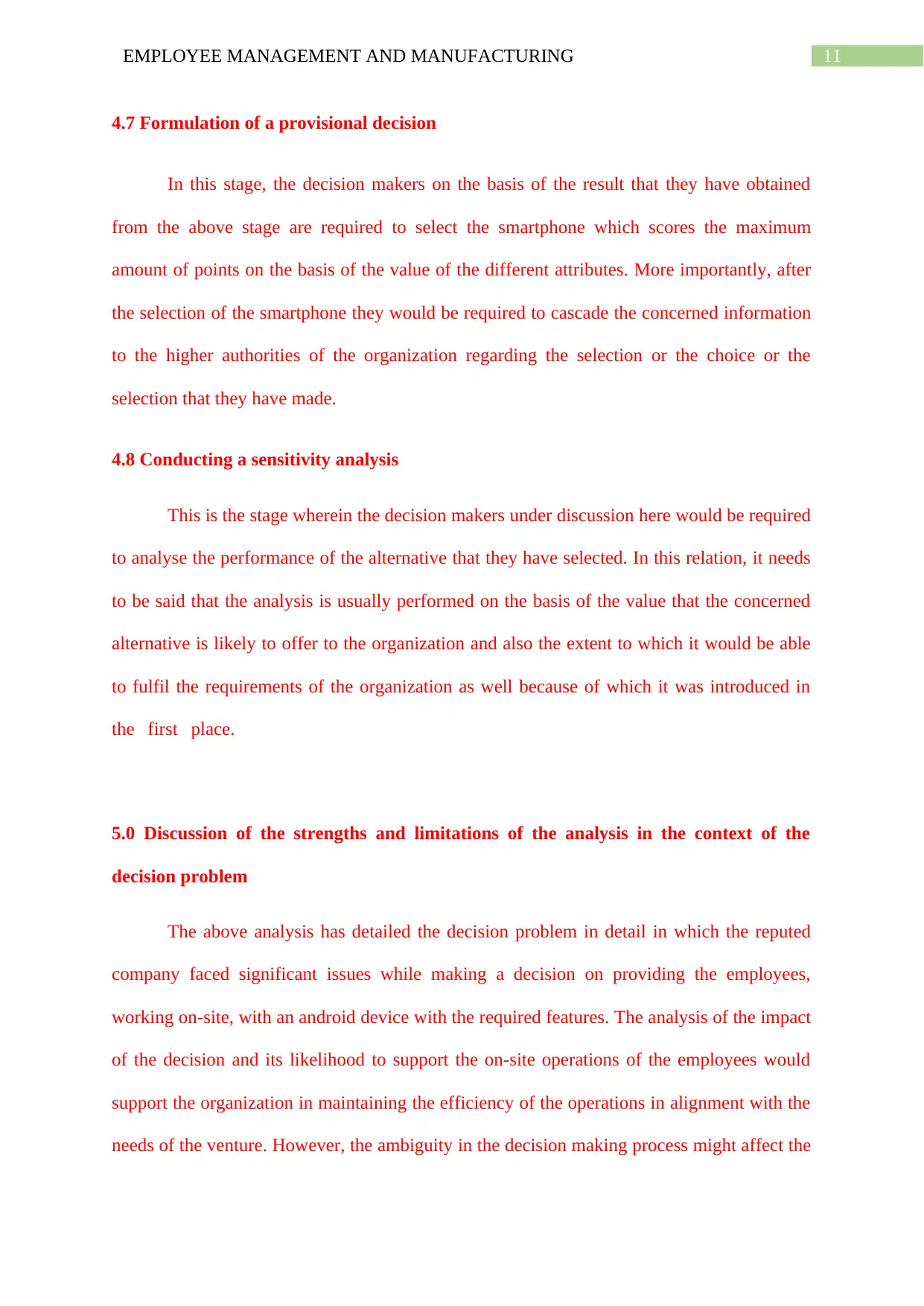
11EMPLOYEE MANAGEMENT AND MANUFACTURING
4.7 Formulation of a provisional decision
In this stage, the decision makers on the basis of the result that they have obtained
from the above stage are required to select the smartphone which scores the maximum
amount of points on the basis of the value of the different attributes. More importantly, after
the selection of the smartphone they would be required to cascade the concerned information
to the higher authorities of the organization regarding the selection or the choice or the
selection that they have made.
4.8 Conducting a sensitivity analysis
This is the stage wherein the decision makers under discussion here would be required
to analyse the performance of the alternative that they have selected. In this relation, it needs
to be said that the analysis is usually performed on the basis of the value that the concerned
alternative is likely to offer to the organization and also the extent to which it would be able
to fulfil the requirements of the organization as well because of which it was introduced in
the first place.
5.0 Discussion of the strengths and limitations of the analysis in the context of the
decision problem
The above analysis has detailed the decision problem in detail in which the reputed
company faced significant issues while making a decision on providing the employees,
working on-site, with an android device with the required features. The analysis of the impact
of the decision and its likelihood to support the on-site operations of the employees would
support the organization in maintaining the efficiency of the operations in alignment with the
needs of the venture. However, the ambiguity in the decision making process might affect the
4.7 Formulation of a provisional decision
In this stage, the decision makers on the basis of the result that they have obtained
from the above stage are required to select the smartphone which scores the maximum
amount of points on the basis of the value of the different attributes. More importantly, after
the selection of the smartphone they would be required to cascade the concerned information
to the higher authorities of the organization regarding the selection or the choice or the
selection that they have made.
4.8 Conducting a sensitivity analysis
This is the stage wherein the decision makers under discussion here would be required
to analyse the performance of the alternative that they have selected. In this relation, it needs
to be said that the analysis is usually performed on the basis of the value that the concerned
alternative is likely to offer to the organization and also the extent to which it would be able
to fulfil the requirements of the organization as well because of which it was introduced in
the first place.
5.0 Discussion of the strengths and limitations of the analysis in the context of the
decision problem
The above analysis has detailed the decision problem in detail in which the reputed
company faced significant issues while making a decision on providing the employees,
working on-site, with an android device with the required features. The analysis of the impact
of the decision and its likelihood to support the on-site operations of the employees would
support the organization in maintaining the efficiency of the operations in alignment with the
needs of the venture. However, the ambiguity in the decision making process might affect the
⊘ This is a preview!⊘
Do you want full access?
Subscribe today to unlock all pages.

Trusted by 1+ million students worldwide
1 out of 18
Related Documents
Your All-in-One AI-Powered Toolkit for Academic Success.
+13062052269
info@desklib.com
Available 24*7 on WhatsApp / Email
![[object Object]](/_next/static/media/star-bottom.7253800d.svg)
Unlock your academic potential
Copyright © 2020–2025 A2Z Services. All Rights Reserved. Developed and managed by ZUCOL.





